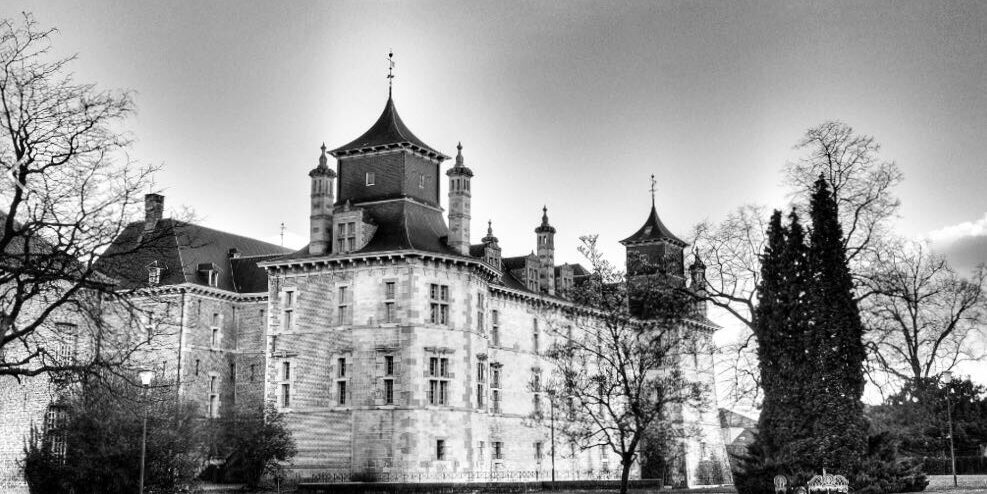Castle d’Aspremont-Lynden, Oud-Rekem (Limburg)
by Eva Weyns (architect-engineer, Belgium), Thérèse Claeys (archaeologist, Belgium), Amable Garcia Enguita (architect-engineer, Spain), and Martin Efremovski (architect-engineer, Macedonia), first-year students
Built in the late XVIth century on top of a motte in Old-Rekem, the castle d’Aspremont-Lynden is an imposing illustration of the Maas Renaissance. Old-Rekem represents the historical cluster of Rekem, located in the province of Limburg and belonging to the municipality of Lanaken. Despite its decentralized position on the Belgian territory, the village benefits from a strategic location at the crossroad between Belgium and the Netherlands. Landmark of “the most beautiful village in Flanders”, the castle is characterized by an eventful settlement tradition stressed by numerous restoration, extension and destruction works throughout history shaping its current appearance. After its abandonment in the 1980s, its reuse for cultural purposes combined with its listing (1994) and a restoration campaign (1992-1998) were insufficient to rescue this glorious testimony of the past from its decay.
How to sustainably ensure the future of an old heritage building facing major present challenges on a macro, meso and micro scales? This generic question applied to our case study led us to adopt a methodology in three steps, namely a subdivision of our study in past, present and future analyses. The past and present studies allow acquiring a deep understanding of the topic while defining its values and issues as a preliminary step before proposing any interventions to guarantee its conservation.
From the motte…
The morphological evolution of the castle is characterized by a succession of at least six building phases preceded by two initial building phases corresponding to the first fortified settlement (XIIth -XIVth century) and whose archaeological remains are still partially visible in the
basement. The castle itself was built in 1597 by Herman van Lynden on an island surrounded by water. Innovative hypotheses concerning the building evolution in its earlier times were formulated from a cross-sources methodology. 1792 denotes a turning point in the functional
evolution of the castle. Indeed, from that moment on the castle lost its initial function and paradoxically opened its doors for the more frail or fragile individuals by its reuse successively as a military hospital (end of the XVIIIth century), a beggar’s home (XIXth century), a re-education school for boys (end of the XIXth century), a beggar’s home again (beginning of the XXth century) and finally as a mental institution until 1980.
…to the disregarded relics of the glorious past…
Despite its assets, the restoration works have damaged the authenticity of the site while obscuring the reading of the remaining historical layers. It offers nowadays the dreadful image of an abandoned castle enclosed in an introverted site suffering from remoteness besides the
poor accessibility towards and inside OldRekem. The pressure coming from the high density of castles in the region influences the lack of a strong promotion policy aimed at the castle d’Aspremont-Lynden. The commitment of different owners on a large-scale site and the lack of support of the new Dutch citizens enjoying an individualistic lifestyle can also be incriminated as major obstacles to any attempt of reconversion. The masterplan of Rekem from 2004 is particularly symptomatic of the negligence of the local authorities towards the castle. Indeed, this masterplan simply omits any reconversion proposals for the castle domain and therefore breaks the strong connection between the castle and the village sanctioned by history. However, the recent collapse of the north-western tower rings alarm bells to the urgent necessity to intervene not to looseonce and for all this heritage building.
…towards a possible radiant revitalization.
Consequently, our master and conservation plans have to encompass not only the building but also its interconnected urban vicinity. Hence, the major challenge of our project was to prescribe sustainable solutions simultaneously on both scales with the final intention of
improving integration between those scales. In order to achieve this aim in an optimum way, our comparative methodology led us to
combine different functions whose strengths and weaknesses could complete each other in a multifunctional reinterpretation of the castle
d’Aspremont-Lynden. Without pretending to be the only and idealistic scenario for the reuse of the castle, our suggestion has at least the virtue of perfectly matching the minimum guidelines inferred from our diverse analyses.
These guidelines are not only driven by the aim of reducing the weaknesses and enhancing the values of Old-Rekem, the castle domain and the main building but also by the aim of creating new opportunities. In that sense, the continuous use of the castle as the most efficient strategy to ensure the conservation of this heritage could be instrumentalized as a major driver for the revitalization of Old-Rekem. These guidelines are governed by a philosophy of conservation focussed on retraining of the past and the authenticity criteria.
Recovering the past at different scales is perceived as a leitmotiv to recover the importance of the castle d’Aspremont-Lynden within the local community and even beyond the boundaries of its enclosure wall.

